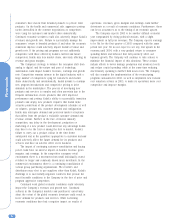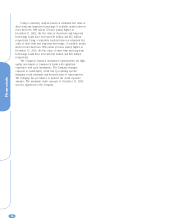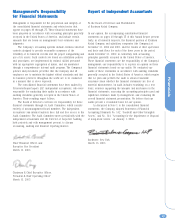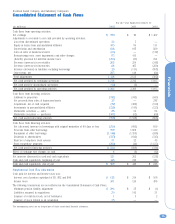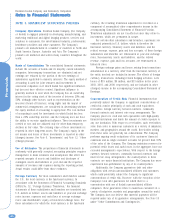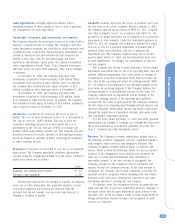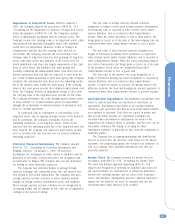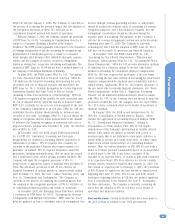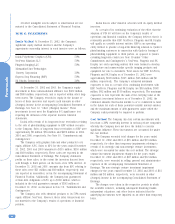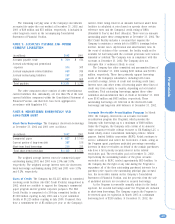Kodak 2002 Annual Report Download - page 46
Download and view the complete annual report
Please find page 46 of the 2002 Kodak annual report below. You can navigate through the pages in the report by either clicking on the pages listed below, or by using the keyword search tool below to find specific information within the annual report.
Financials
46
For equipment sales, the recognition criteria are generally
met when the equipment is delivered and installed at the
customer site. In instances in which the agreement with the
customer contains a customer acceptance clause, revenue is
deferred until customer acceptance is obtained, provided the
customer acceptance clause is considered to be substantive. For
certain agreements, the Company does not consider these
customer acceptance clauses to be substantive because the
Company can and does replicate the customer acceptance test
environment and performs the agreed upon product testing prior
to shipment. In these instances, revenue is recognized upon
installation of the equipment.
The sale of equipment combined with services, including
maintenance, and/or other elements, including products and
software, represent multiple element arrangements. The Company
allocates revenue to the various elements based on verifiable
objective evidence of fair value (if software is not included or is
incidental to the transaction) or Kodak-specific objective evidence
of fair value if software is included and is other than incidental
to the sales transaction as a whole. Revenue allocated to an
individual element is recognized when all other revenue
recognition criteria are met for that element.
Revenue from the sale of integrated solutions, which includes
transactions that require significant production, modification or
customization of software, is recognized in accordance with
contract accounting. Under contract accounting, revenue should
be recognized utilizing either the percentage-of-completion or
completed-contract method. The Company currently utilizes the
completed-contract method for all solution sales as sufficient
history does not currently exist to allow the Company to
accurately estimate total costs to complete these transactions.
Revenue from other long-term contracts, primarily government
contracts, is generally recognized using the percentage-of-
completion method.
The Company may offer customer financing to assist
customers in their acquisition of Kodak’s products, primarily in
the area of on-site photofinishing equipment. At the time a
financing transaction is consummated, which qualifies as a sales-
type lease, the Company records the total lease receivable net of
unearned income and the estimated residual value of the
equipment. Unearned income is recognized as finance income
using the interest method over the term of the lease. Leases not
qualifying as sales-type leases are accounted for as operating
leases. The underlying equipment is depreciated on a straight-line
basis over the assets’ estimated useful life.
The Company’s sales of tangible products are the only class
of revenues that exceeds 10% of total consolidated net sales. All
other sales classes are individually less than 10%, and therefore,
have been combined with the sales of tangible products on the
same line in accordance with Regulation S-X.
Warranty Costs The Company has warranty obligations in
connection with the sale of its equipment. The original warranty
period for equipment products is generally one year. The costs
incurred to provide for these warranty obligations are estimated
and recorded as an accrued liability at the time of sale. The
Company estimates its warranty cost at the point of sale for a
given product based on historical failure rates and related costs to
repair. The change in the Company’s accrued warranty obligations
from December 31, 2001 to December 31, 2002 was as follows:
(in millions)
Accrued warranty obligations
at December 31, 2001 $ 50
Actual warranty experience during 2002 (47)
2002 warranty provisions 48
Adjustments for changes in estimates (8)
Accrued warranty obligations at December 31, 2002 $43
The Company also offers extended warranty arrangements to
its customers, which are generally one year but may range from
three months to three years after the original warranty period.
The Company provides both repair services and routine
maintenance services under these arrangements. The Company
has not separated the extended warranty revenues and costs from
the routine maintenance service revenues and costs, as it is not
practicable to do so. Costs incurred under these extended
warranty arrangements for the year ended December 31, 2002
amounted to $179 million. The change in the Company's deferred
revenue balance in relation to these extended warranty
arrangements was as follows:
(in millions)
Deferred revenue at December 31, 2001 $ 91
New extended warranty arrangements in 2002 330
Recognition of extended warranty arrangement
revenue in 2002 (318)
Deferred revenue at December 31, 2002 $103
Research and Development Costs Research and
development costs, which include costs in connection with new
product development, fundamental and exploratory research,
process improvement, product use technology and product
accreditation are charged to operations in the period in which
they are incurred.
Advertising Advertising costs are expensed as incurred and
included in selling, general and administrative expenses.
Advertising expenses amounted to $632 million, $634 million and
$701 million in 2002, 2001 and 2000, respectively.
Shipping and Handling Costs Amounts charged to customers
and costs incurred by the Company related to shipping and
handling are included in net sales and cost of goods sold,
respectively, in accordance with Emerging Issues Task Force
(EITF) Issue No. 00-10, “Accounting for Shipping and Handling
Fees and Costs.”


